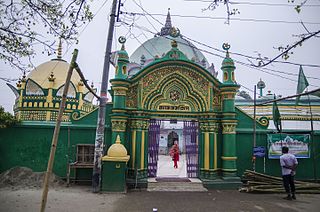Rajshahi Division is one of the eight first-level administrative divisions of Bangladesh. It has an area of 18,174.4 square kilometres (7,017.2 sq mi) and a population at the 2022 Census of 20,353,119. Rajshahi Division consists of 8 districts, 70 Upazilas and 1,092 Unions.

Varendra Museum is a museum, research centre, and popular visitor attraction at the heart of Rajshahi and maintained by Rajshahi University in Bangladesh. It is considered the oldest museum in Bangladesh. It was the first museum to be established in East Bengal in 1910. The museum started out as the collection for Varendra Anushandan Samiti and got its current name in 1919. The Rajahs of Rajshahi and Natore, notably prince Sharat Kumar Ray, donated their personal collections to Varendra Museum. Varendra refers to an ancient Janapada roughly corresponding to modern northern Bangladesh.

Natore district is a district of Rajshahi Division located in northern Bangladesh. It borders the metropolitan city of Rajshahi and used to be a part of Rajshahi district.

Isa Khan was the Bais Rajput leader of the 16th-century Baro-Bhuiyan chieftains of Bengal and a zamindar of Khizrpur. During his reign, he successfully unified the chieftains of Bengal and resisted the Mughal invasion of Bengal. It was only after his death that the region fell totally under Mughal control. He remains an iconic figure throughout West Bengal and Bangladesh as a symbol of his rebellious spirit and unity.

Kushtia District is a district in the Khulna administrative division of western Bangladesh. Kushtia is the second largest municipality in Bangladesh and the eleventh largest city in the country. Kushtia has existed as a separate district since the partition of India. Prior to that, Kushtia was a part of Nadia district. Kushtia is the birthplace of many historical figures including Mir Mosharraf Hossain (1847–1912), Bagha Jatin (1879–1915) and Lalon (1774–1890). Nobel laureate poet Rabindranath Tagore lived his early life at Shelaidaha.

Rajshahi District is a district in mid-western Bangladesh. It is a part of the Rajshahi Division. The metropolitan city of Rajshahi is in Rajshahi District.

Sirajganj District is a district in the North Bengal region of Bangladesh, located in the Rajshahi Division. It is an economically important district of Bangladesh. Sirajganj district is the 25th largest district by area and 9th largest district by population in Bangladesh. It is known as the gateway to North Bengal.

Rani Bhabani (1716–1803), also known as Ardhabangeshwari(অর্ধবঙ্গেশ্বরী) and Natorer Rani or the Queen of Natore, was a Hindu zamindar during the British colonial era in what is now Rajshahi, Bangladesh. She became the zamindar after the death of her husband Raja Ramkanta Moitra (Ray), 'Zamindar' of Natore estate. The Rajshahi Raj or Natore estate was a large zamindari which occupied a vast position of Bengal. The Natore estate had an area of nearly 34,000 square kilometres (13,000 sq mi) and included not only much of North Bengal but also large parts of the areas later comprising the administrative districts of Murshidabad, Nadia, Jessore, Birbhum and Burdwan. After the death of her husband, Rani Bhabani of Natore Rajbari, expanded both the estate and the palace.

Bikrampur was a pargana situated 19 kilometres (12 mi) south of Dhaka, the modern capital city of Bangladesh. In the present day, it is known as Munshiganj District of Bangladesh. It is a historic region in Bengal and was a part of the Bhawal Estate.
Singra is an upazila of Natore District in the Division of Rajshahi, Bangladesh.
Bagha is an upazila of the Rajshahi District, located in Bangladesh's Rajshahi Division.
The Singranatore family is the consanguineous name given to a noble family in Rajshahi of landed aristocracy in erstwhile East Bengal and West Bengal that were prominent in the nineteenth century till the fall of the monarchy in India by Royal Assent in 1947 and subsequently abolished by the newly formed democratic Government of East Pakistan in 1950 by the State Acquisition Act.

Varendra, also known as Barind, was a region of North Bengal, now mostly in Bangladesh and a little portion in the Indian state of West Bengal.
Ruknuddīn Bārbak Shāh was the son and successor of Sultan Nasiruddin Mahmud Shah. Initially appointed as the governor of Satgaon during the reign of his father, Barbak ascended the throne of the Bengal Sultanate in 1459. He was the first ruler to give prominent roles in the Sultanate's administration to the Abyssinian community. Historian Aniruddha Ray credits Barbak Shah as the pioneer of urbanisation in Bengal.

Natore Rajbari was a prominent royal palace in Natore, Bangladesh. It was the residence and seat of the Rajshahi Raj family of zamindars. The famous queen Rani Bhabani lived here and after the death of her husband, expanded both the estate and the palace.

Dighapatia Raj was a zamindari in present-day Rajshahi, which was ruled by this dynasty of 7 generations of Rajas from early 18th century till the mid-20th century; when the democratic government took power after the end of the British Monarchy's rule in India, in 1950, the East Pakistan government abolished aristocracies and the zamindari system in present-day Bangladesh. The family was seated at the Dighapatia Palace.

Zamindars of Natore were influential aristocratic Bengali Zamindars, who owned large estates in what is today Natore District in Bangladesh .
Maharaja Jagadindra Nath Roy Bahadur (Moitra) (20 October,1868- 5 January,1925) known as the Maharaja of Natore was a noted zamindar of Natore from Bengal. He is also noted for his contribution to the game of cricket in British India.

The Chowdhuries of Natore are a notable Bengali Muslim family who have played important roles throughout the history of North Bengal.













